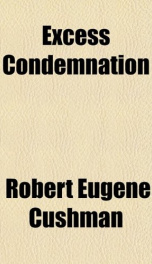excess condemnation

Purchase of this book includes free trial access to www.million-books.com where you can read more than a million books for free. This is an OCR edition with typos. Excerpt from book: CHAPTER III EXCESS CONDEMNATION FOR THE PROTECTION OF PUBLIC IMPROVEMENTS One of the principal purposes for which it is proposed to use excess condemnation is to protect public improvements by preventing the adjoining property from being put to uses which directly or indirectly injure those improvements and prevent them from serving in the fullest 3egree the ends for which they were created.1 This will very frequently be an esthetic protection, andjjexcess condemnation is sometimes spoken of as a means of promoting the " city beautiful." It would be amistekejJ1qweYfir, to regard it exclusively as a method of advancing the cause of civic beauty. Just as city planning is not solely the function of the artist and the architect; just as a park, beautiful as it may be, is dedicated also to public health and play; so the protection afforded by excess condemnation is not confined to the beauty of a public improvement, but extends to the health, light, air, convenience and general usefulness of it. jit is the purpose of this chapter to discuss excess condemnation as a means of thus protecting public improvements. Those who look upon excess condemnation as a meansof conserving the beauty and convenience of the modern city especially urge its application to the problem of securing and preserving suitable sites for public buildings and places. And since this problem has several unique and interesting features, it may be well to dispose of it before proceeding to the more general discussion. 1 This statement is of course broad enough to include the use of excess condemnation as a means of dealing with remnants of land. While the taking and replotting of remnants is a method of protecting a public improvement, the evil to be dealt with is, however, rooted in so specific a cause ...
Users who have this book
Users who want this book
What readers are saying
What do you think? Write your own comment on this book!
write a commentif you like excess condemnation try:
Other books by this author
Do you want to read a book that interests you? It’s EASY!
Create an account and send a request for reading to other users on the Webpage of the book!



